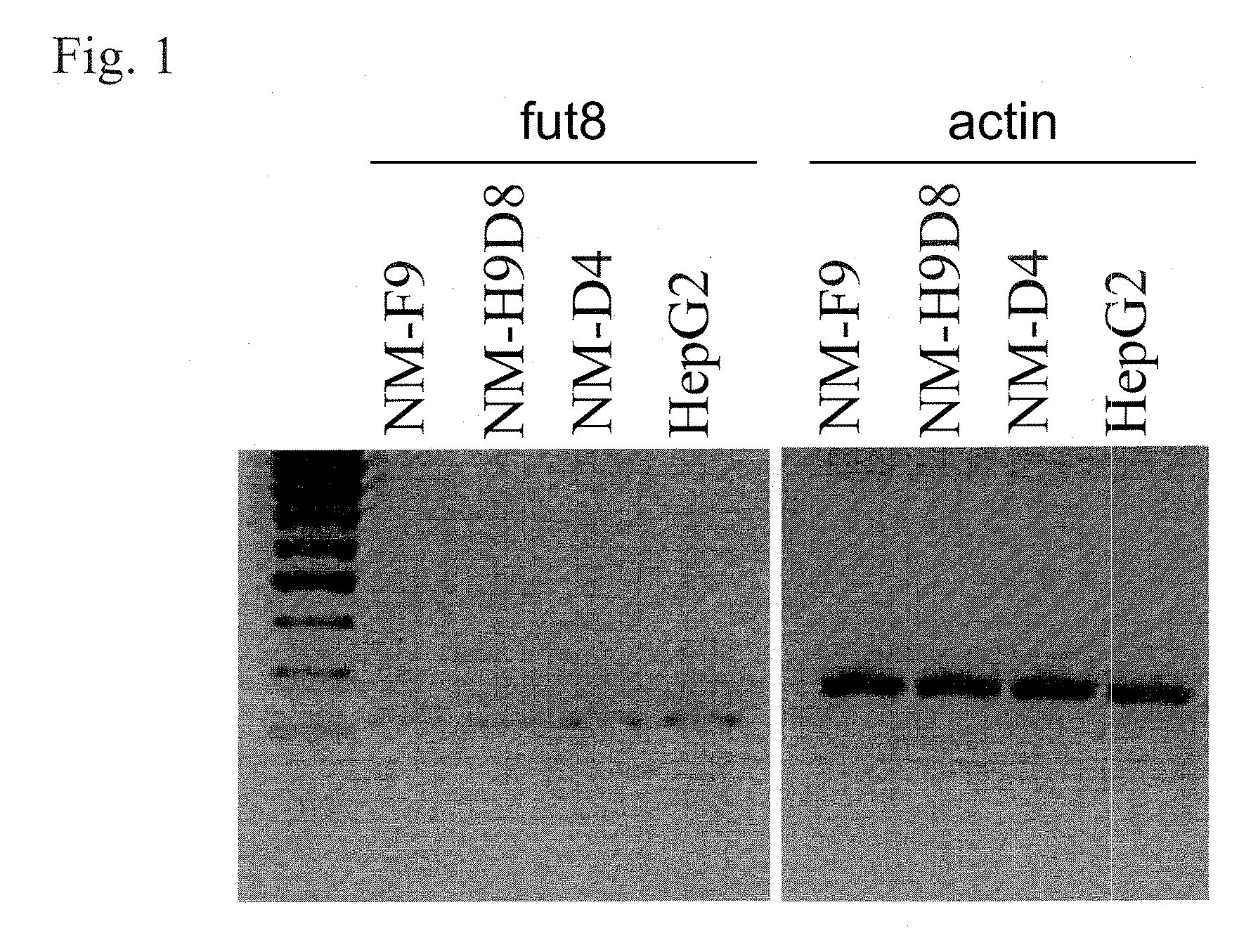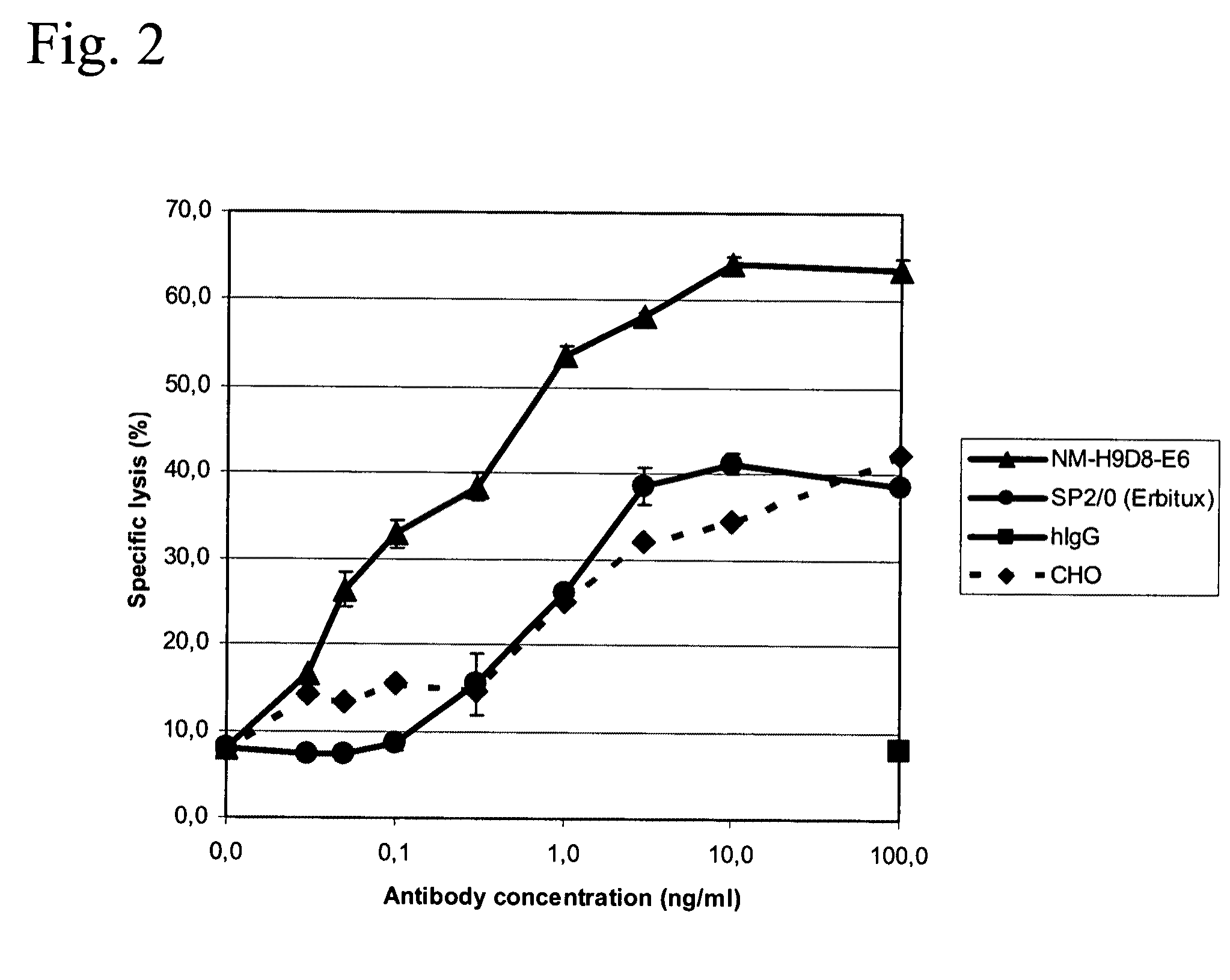Use of human cells of myeloid leukaemia origin for expression of antibodies
a technology of myeloid leukaemia and human cells, which is applied in the direction of immunoglobulins, peptides/protein ingredients, peptides, etc., can solve the problems of adverse immune response, multi-step process with additional costs, losses and time, and established cellular production systems are unable to produce proteins with the original human glycosylation
- Summary
- Abstract
- Description
- Claims
- Application Information
AI Technical Summary
Benefits of technology
Problems solved by technology
Method used
Image
Examples
example 2
Glycoengineering of K562 Cells
[0403]Glycoengineering of K562 cells and generation of NM-D4 and NM-F9 cell line are described in EP1654353.
[0404]NM-H9 cells, and a cell or cell line derived therefrom with high sialylation potential were generated as follows. Random mutagenesis was performed by treating K562 cells with the alkylating agent ethyl methanesulfonate. Per sample K562 cells were washed in PBS and seeded at 106P cells per ml cell culture medium supplemented with EMS (0.1 mg / ml, ethyl methanesulfonate, Sigma-Aldrich) overnight at 37° C. and 5% COB2B. Cells were washed and provided with fresh medium. Every second day cell vitality was determined by trypan blue staining, and cells were analysed by immunocytochemical staining.
[0405]Subsequently, cells exposing the novel phenotype of high TF expression were selected by means of a TF-specific antibody. K562 cells were washed in B-PBS (0.5% BSA in PBS), incubated with 50 μl of supernatant of hybridoma cultures of the monoclonal ant...
example 3
Cultivation of K562, NM-F9, NM-D4, NM-H9, NM-E-2F9, NM-C-2F5, NM-H9D8, NM-H9D8-E6, NM-H9D8-E6Q12, and GT-2x Cell Lines and CHOdhfr- Cells and Generation of Serum Free Cell Lines
[0407]K562, NM-F9, NM-D4, NM-H9, NM-E-2F9, NM-C-2F5, NM-H9D8 [DSM ACC2806], NM-H9D8-E6 [DSM ACC2807], NM-H9D8-E6Q12 [DSM ACC2856 at the “DSMZ-Deutsche Sammlung von Mikroorganismen und Zellkulturen GmbH” in Braunschweig (Germany), by Glycotope GmbH, Robert-Rössle-Str. 10, 13125 Berlin (Germany) on Aug. 8, 2007], or GT-2x [DSM ACC ______] were cultured in RPMI 1640 supplemented with 10% FCS and 2 mM glutamine or serum free in X-Vivo 20 medium and grown at 37° C. in a humidified atmosphere of 8%.
[0408]CHOdhfr- cells (ATCC No. CRL-9096) were cultured in DMEM supplemented with 10% FCS, 2 mM glutamine, and 2% HT supplement or serum free in CHO-S-SFM II medium and grown at 37° C. in a humidified atmosphere of 8%.
[0409]K562, NM-F9, NM-D4, NM-H9, NM-E-2F9, NM-C-2F5, NM-H9D8 [DSM ACC2806], NM-H9D8-E6 [DSM ACC2807], NM-...
example 4
Cloning of Vectors to Express the Chimeric Antibodies PankoMab, Panko1, Panko2, or Cetuximab in Eukaryotic Cells
[0411]Variable sequences of PankoMab were PCR amplified with specific primers from the murine hybridoma cells producing PankoMab [H Cancer Immunol Immunother. H 2006 November; 55(11):1337-47. Epub 2006 Feb. PankoMab: a potent new generation anti-tumour MUC1 antibody. Danielczyk et al].
[0412]Variable sequences VH and VL of Panko1 and Panko2 are described in WO2004 / 065423, herein incorporated by reference.
Variable Heavy chain of Panko1:EVKLVESGGGLVQPGGSMKLSCAASGFTFSDAWMDWVRQSPEKGLEWVAEIRSKANNHATYYAESVKGRFTISRDVSKSSVYLQMNNLRAEDTGIYYCTRGGYGFDWGQGTTLTVSVariable Light chain of Panko1:DIVLTQTPLSLPVSLGDQASISCRSSQSIVHSNGNTYLEWYLQKPGQSPKLLIYKVSNRFSGVPDRFSGSGSGTDFTLKISRVEAEDLGVYYCFQGSHVPLTFGDGTKLELKRVariable Heavy chain of Panko2:EVKLVESGGGLVQPGGSMKLSCVASGFTFSNYWMNWVRQSPEKGLEWVAEIRLKSNNYTTHYAESVKGRFTISRDDSKSSVSLQMNNLRVEDTGIYYCTRHYYFDYWGQGTTLTVSVariable Light chain of Panko2:DIVMTQAAF...
PUM
| Property | Measurement | Unit |
|---|---|---|
| doubling time | aaaaa | aaaaa |
| concentrations | aaaaa | aaaaa |
| concentrations | aaaaa | aaaaa |
Abstract
Description
Claims
Application Information
 Login to View More
Login to View More - R&D
- Intellectual Property
- Life Sciences
- Materials
- Tech Scout
- Unparalleled Data Quality
- Higher Quality Content
- 60% Fewer Hallucinations
Browse by: Latest US Patents, China's latest patents, Technical Efficacy Thesaurus, Application Domain, Technology Topic, Popular Technical Reports.
© 2025 PatSnap. All rights reserved.Legal|Privacy policy|Modern Slavery Act Transparency Statement|Sitemap|About US| Contact US: help@patsnap.com



